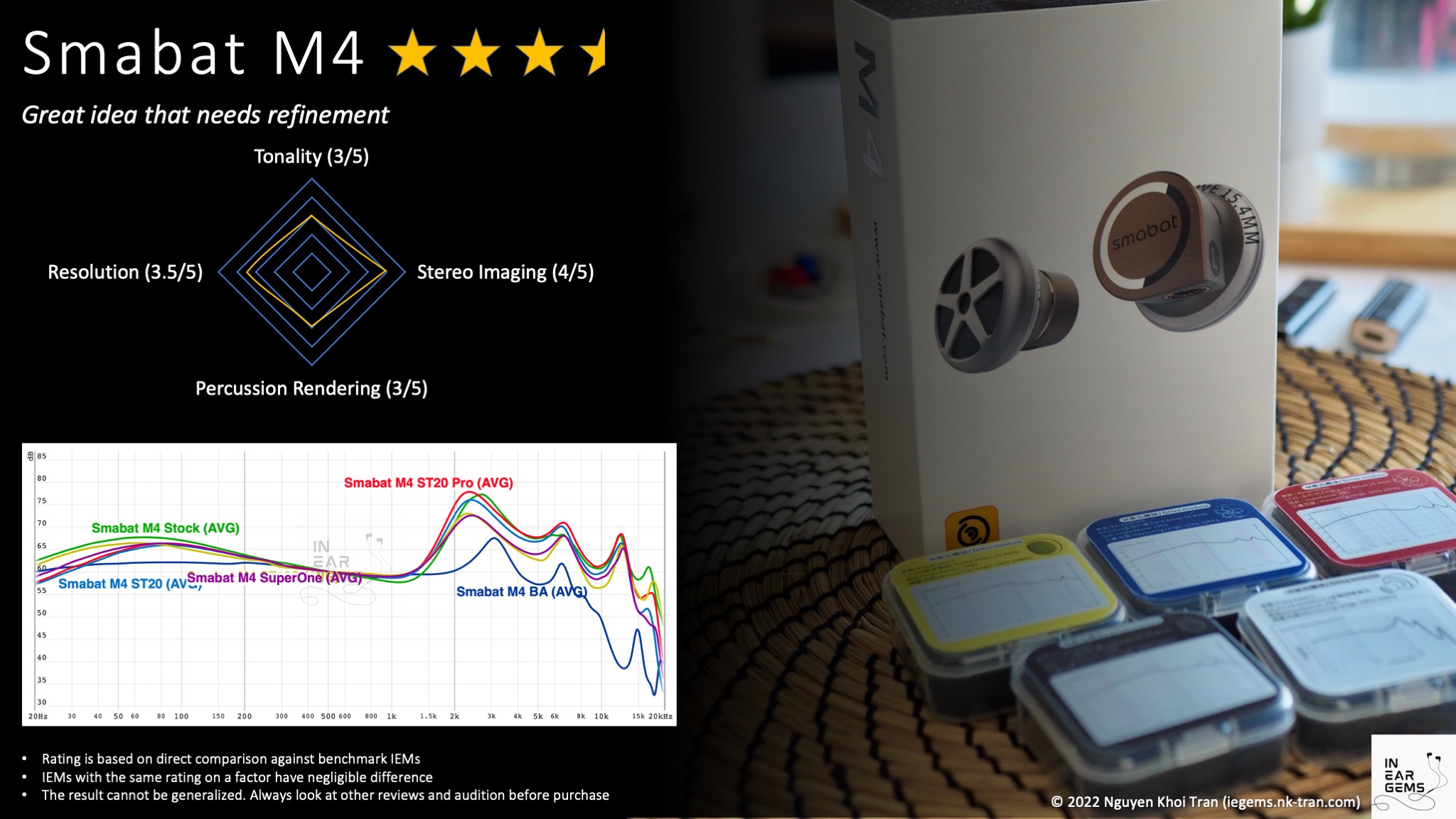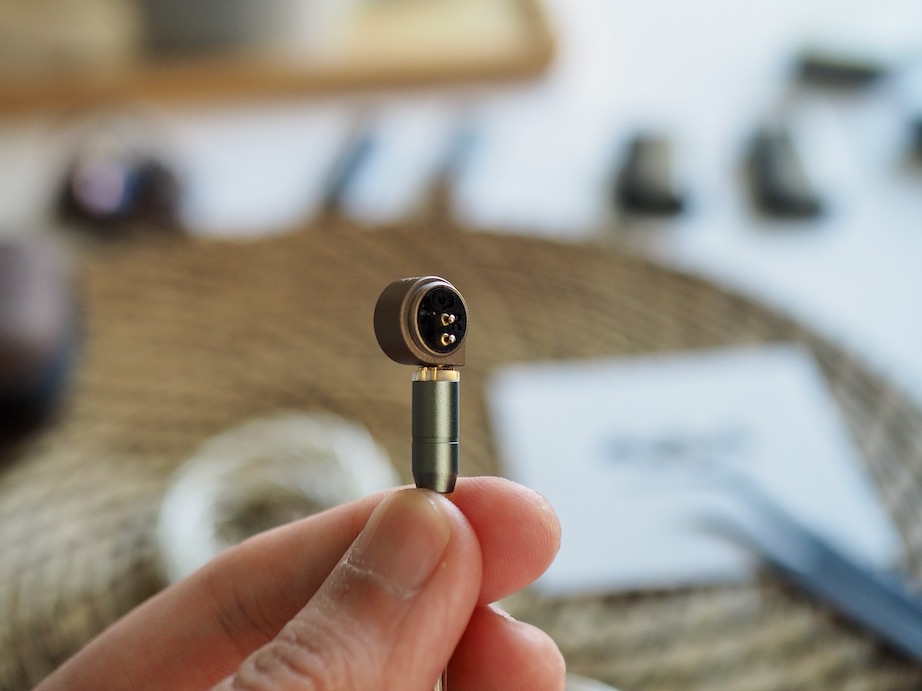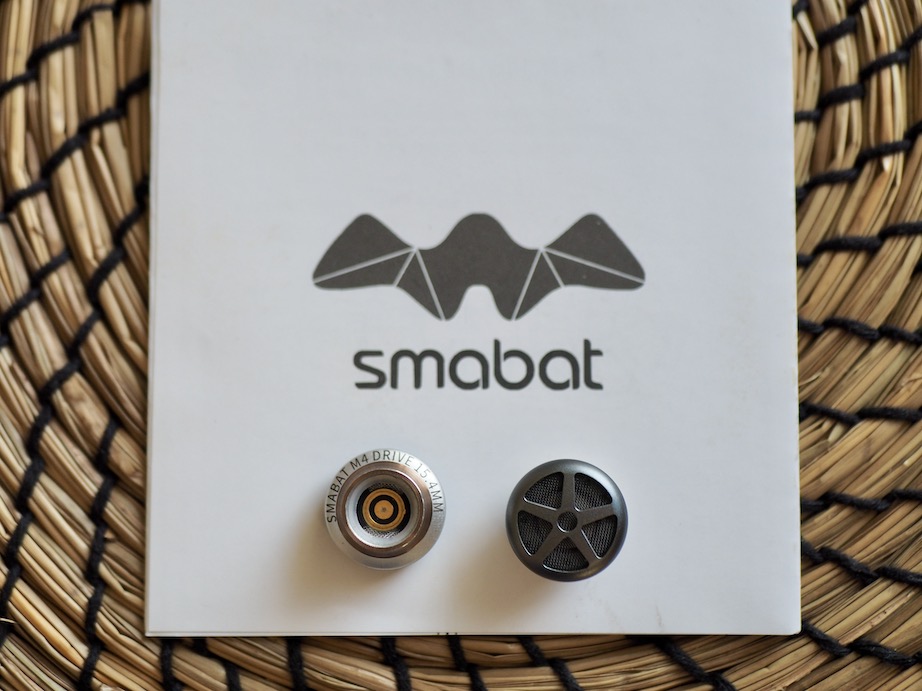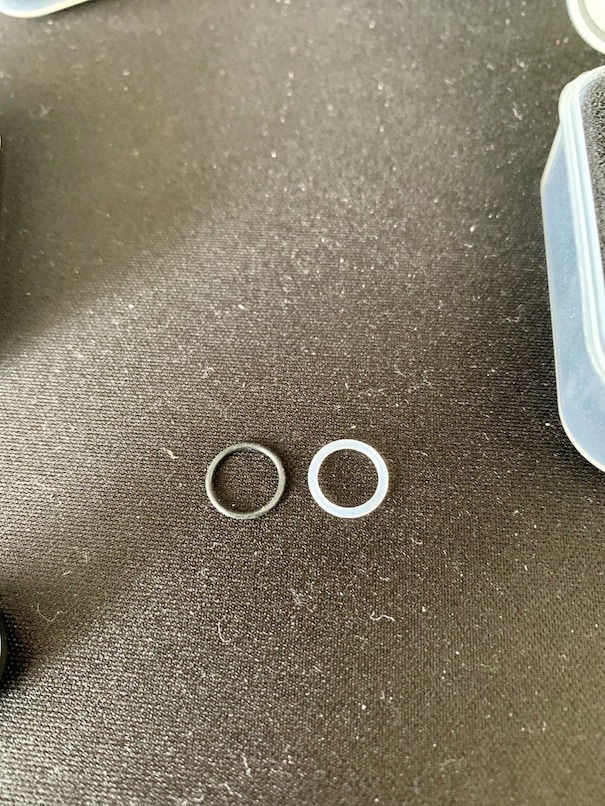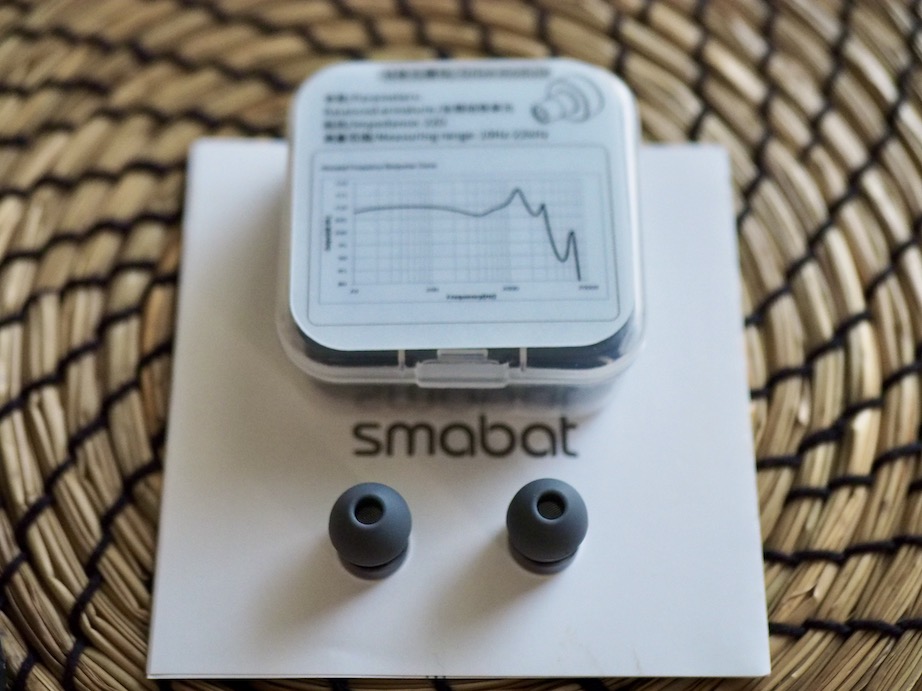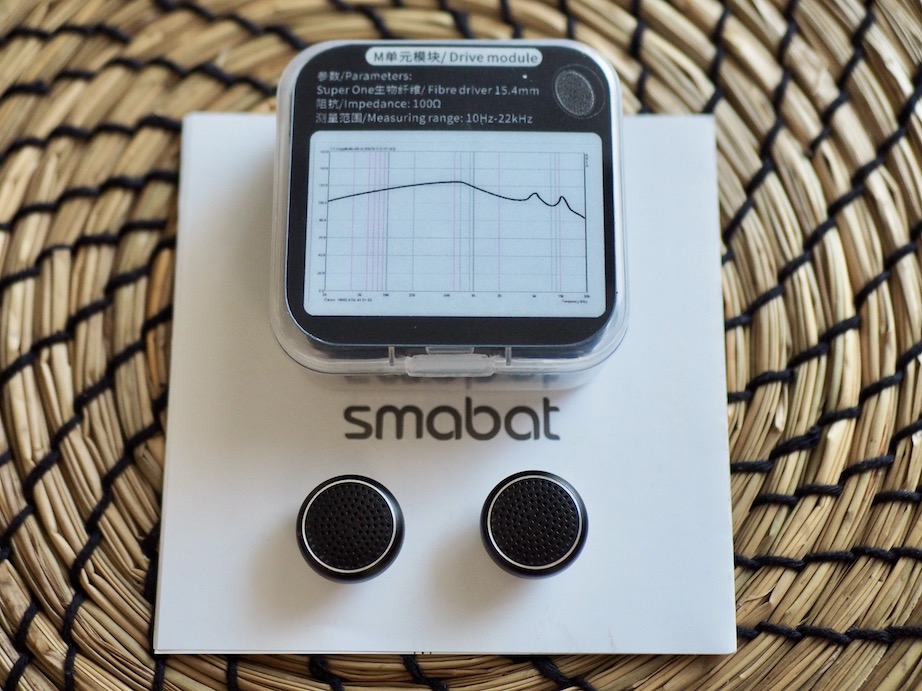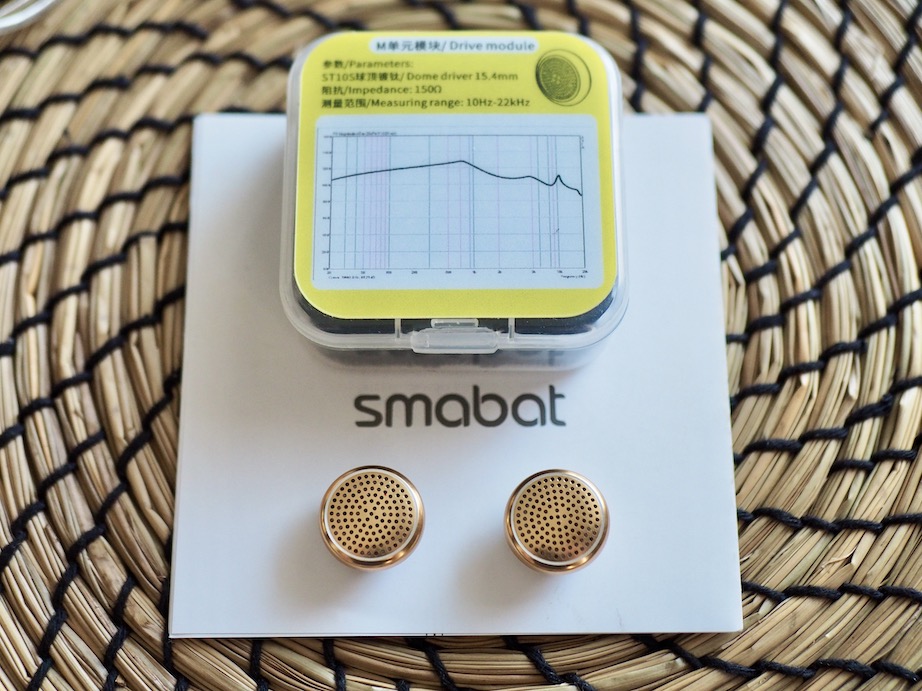Smabat M4 - Great idea that needs refinement
Do you want to build and tune your own earphones to create your unique sound? Do you like to share that unique sound with others?
This ability has been limited to handy DIYers and influential audiophile reviewers. However, Smabat has been trying to change this situation with modular IEMs and earphones. The idea is that you can buy the main body unit and a couple of different drivers and filters to put together a unique pair of IEMs or earphones. The assembly process can be done without soldering.
I love the idea. However, can the idea stand up to the cruelty of reality?
Let’s talk about M4, the latest generation of modular earphones from Smabat.
tl;dr: the modular idea works, but more refinement is still necessary. The complexity of a modular design brings about defects and inconsistencies. The selection of drivers needs more variety as they centre around Smabat’s house sound. If you are searching for a warm and relaxing sound signature, keep searching. These are not the buds you are looking for.
Forewords
- I purchase M4 and all drivers at a discount to facilitate this review. Smabat also replaced the M4 body and all of the dynamic drivers once to address a potential defect. I have no financial interest in Smabat or the success of M4.
- I rate IEMs by A/B testing them against a few benchmark IEMs, regardless of price point. If a $1000 IEM scores the same as a $100 IEM, then either the more expensive one underperforms or the budget one is a gem.
- I believe that great IEMs are the ones that can achieve multiple difficult things simultaneously: (1) high resolution (meaning lines of music are crisp, clear, easy to follow and full of texture), (2) 3D soundstage with a strong sense of depth, (3) bold and natural bass with a physical rumble, (4) natural timbre, (5) relaxing and comfortable tonality. IEMs achieving those criteria are rated highly in my ranking list
- I use frequency response measurements to double-check my subjective impressions.
- Ranking list and measurement database can be found on my IEM review blog.
What is Smabat M4
M4 is a flathead earbud with interchangeable drivers and replaceable cable (MMCX connector). Each earpiece comprises a main body unit and a screw-on driver unit. The body unit contains a “3D structure, “ essentially a bass tube connected to a vent. This structure enhances M4’s bass response and allows you to fine-tune the level of the “V-shape” of M4’s sound.
Most driver units contain a 15.4mm dynamic driver. The driver is attached to a metal structure with two circular connection pads, a pair of vents, and the threads for screwing onto the main body unit.
Hidden in the drivers are o-rings that ensure the seal between the main body unit and the drivers. This seal is critical for getting the right sound out of M4. Earlier batches of M4 drivers come with white o-rings that tend to pop out from the drivers and prevent them from screwing onto the main body unit correctly. Some of my replacement M4 drivers come with black o-rings that fit better.

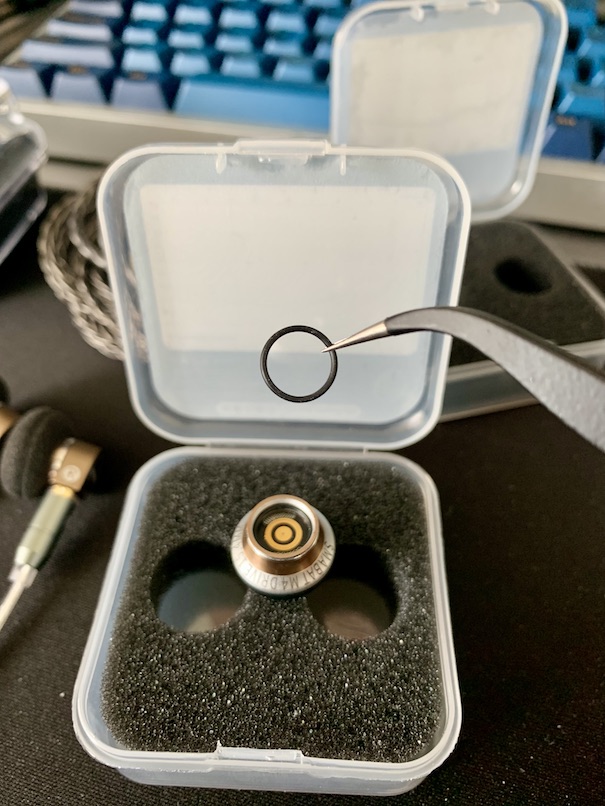
Smabat also sells a set of balanced armature (BA) drivers. These drivers belong to the Bellsing Hornet series. The BA driver units are not influenced by the bass tubes on the main body unit, so they are not sensitive to manufacturing variations in the screw thread.
How to buy M4
The simplest way to buy Smabat M4 is to get a “starter kit” that gives you everything you need to create a functional M4. This kit includes the main body units, 1 pair of easy-to-drive drivers, an MMCX cable, a carrying case, and six pairs of foam. This starter kit was my option when I purchased my M4.
Alternatively, you can buy the main body units and drivers individually. This option is good when you know the drivers you want and already have spare cables and foams. This option was how Smabat sent me a replacement unit.
You should also grab the tuning filter kit even if you already have some DIY IEM filters because the filters used by M4 are pretty small.
How to tune M4
The first way of tuning M4 is by replacing the filter on the main body unit. There are four types of filters, labelled as 1, 2, 3, and 2.5 (the default filters on the main body units). A higher number indicates a higher resistance (thicker).
How do the filters work? The same as when you tune bell-shaped flathead earbuds with a big opening at the back. If you want a lot of upper-midrange and a lot of midbass with a big dip around 1kHz, use thinner filters. If you want a less contrasty presentation, use thicker filters. You can see measurements with my IEC 711 coupler below.
The second way of tuning M4 is by replacing the drivers. The drivers have a slight difference in true resolution and the amount of bass. However, their tuning is consistent with the Smabat house sound. In other words, if you want a pair of warm and dark buds, you can’t achieve that with M4.
A note on channel imbalance and manufacturing defects
As I have alluded to a couple times in this review, I have received a new set of main body units and dynamic drivers as a replacement for the first set.
So, what happened? One driver in every pair cannot screw onto the main body unit. The screw thread on both sides refuses to connect unless I press them together tightly. Even when they were screwed in, there was still a 1mm gap. As a result, the frequency response of both channels differed significantly. Moreover, tuning filters did not work on the defective side.
After a discussion via email, Smabat reacted promptly and sent over a replacement set of main bodies and drivers. Some drivers have new black o-rings, which fit better and negate all the connection problems.
It should be noted that the channel difference still appears in measurement, particularly around the ear-gain region. However, the problem is not very noticeable in real-world listening, especially with the Type 3 filters.
How it sounds
Casual listening sessions were done with Fiio KA3, Fiio BTR5, Hidizs AP80 Pro X, Hidizs S9 Pro, Hidizs XO, and Topping G5.
All A/B tests were done using Topping G5.
Local FLAC files ripped from CDs or bought from Qobuz were used for most casual listening and A/B tests.
Tonality and Timbre: 3/5 - Average
 Frequency response of all configurations. Measurements were done with an IEC-711-compliant coupler and might only be compared with other measurements from this same coupler. Visit my graph database for more comparisons.
Frequency response of all configurations. Measurements were done with an IEC-711-compliant coupler and might only be compared with other measurements from this same coupler. Visit my graph database for more comparisons.
Tonality: Crisp, clear, and forward, but can be fatiguing and not the most natural. All drivers exhibit a similar tuning with reduced lower-midrange and forward upper-midrange (ear gain). If you are used to a warm and rich tuning, M4 can sound unbearably thin and strident.
In fact, harsher vocals like Bon Jovi in Wanted Dead or Alive can sound harsh and shouty (to put it simply: too loud comparing to the rest of the mix). However, I’m still determining whether this harshness is due to the tuning choice of Smabat or the defective drivers that do not seal properly.
For me, the type 3 filter and a bit of brain burn-in (a.k.a., getting used to the sound) bring the tuning down within my tolerance level. I would say the Smabat house sound is more suitable for higher-pitched vocals and instruments. For instance, Can’t help falling in love by Kacey Musgraves sounds fantastic with M4: clear, intimate, detailed, and emotive. Meanwhile, Bach suites for cello solo by Mischa Maisky sounds a little thin and a bit off, especially when he plays the lower strings.
Despite the forward and strident upper midrange, the treble of M4 is smooth but not weak. I did not hear any “treble glare” (i.e., that random bright sound stabbing in the ears when musicians strike cymbals or pluck a guitar string). Cymbals, hi-hats, and chimes in Wanted Dead or Alive sound controlled and detailed rather than splashy.
The bass of M4 is generally “tight” and clean, focusing on the punch (“boom boom” sound) rather than the deep rumble that makes up the physical body of bass notes. Note that the bass feels even more weightless in some configurations because you must turn down the volume to reduce the stabbing ear gain.
Different drivers balance low and upper midrange differently, but the tonality and timbre never venture far from the house sound. You can tame the house sound somewhat by using a warmer driver and a type 3 filter. In the most optimal configuration, I rate the tonality of M4 3/5 - Adequate, if and only if the drivers seal against the main body unit properly.
Resolution, Detail, Separation: 3.5/5 - Above Average

All M4 drivers have a high degree of perceived resolution in the midrange due to how they are tuned. It means that note attacks are emphasized and crisp. The whole stereo image is clear and sharp, just like looking at a vibrant and contrasty TV. In A/B tests, the difference in clarity between M4 and Aria, my standard for acceptable resolution (3/5), is noticeable and appreciated.
However, the true resolution of M4 is only average to slightly above average. By true resolution, I mean the ability of a driver (and its enclosure design) to finely distinguish similar sounds placed closely within the soundstage or in a fast passage. If we continue with the TV analogy, M4 is more like an overly sharpened full HD screen than a proper 4k screen. It is only sharp and clear when not too much is going on.
Another indicator of the true resolution is in the texture or “micro-detail” of vocal lines such as Andrea Bocelli’s in Besame Mucho, Bon Jovi in Wanted Dead or Alive, or violin solos performed by James Ehnes. M4 fails to dig into a deeper level of micro details and texture that I hear with my Blessing 2, my standard for “good” resolution (4/5). However, it does not feel overly smoothened like some worse performers in my collection.
Based on the A/B tests, I rate the resolution of M4 3.5/5 - above average.
Percussion Rendering: 3/5 - Adequate
Percussion rendering reflects how well the tuning and technical performance of an IEM work together to recreate realistic sound of a drum set. Good drum hits have a crisp attack (controlled by frequencies from 4kHz to 6kHz), full body (midbass frequencies around 200Hz), and physical sensation (sub-bass frequencies around 50Hz). Good technical performance (“fast” driver) ensures that bass notes can be loud yet detailed. IEMs that cannot control bass very well tend to reduce the bass’ loudness to prevent muddiness.
Across all configurations, the M4 have a punchy but focused bass. This is achieved by focusing the energy to 150Hz and below and cutting back the frequencies around 250Hz. As a result, drums feel tight and clean but maintain a good presence in the mix. Drum attacks sound “quick” and snappy. The pillowy bass, like punching a pillow, common among overly-dampened IEMs do not exist with M4.
However, besides the cleanness, the drums on M4 do not sound particularly interesting. M4 still outdoes many flathead earbuds in percussion rendering. Still, the clean and focused bass prevents M4 from sounding big, bold, and engaging.
Based on A/B tests and casual listening sessions, I rate the percussion rendering of M4 3/5 - Adequate.
Stereo Imaging (Soundstage): 4/5 - Good
Stereo imaging or “soundstage” is a psychoacoustic illusion that different recording elements appear at various locations inside and around your head. Your brain creates based on the cues such as the loudness and phase differences between the left a nd right channels. Most IEMs do not differ significantly, nor can they compete with headphones or loudspeakers. However, some IEMs offer a more spacious soundstage than others. Best IEMs can create multiple layers of sound from closer to further away and make some instruments float slightly above your head.

Flathead earbuds are great performers in soundstage imaging by design. Some earbuds can sound like a pair of open or semi-open headphones. Some can be modified and tuned to produce a forward projection of the centre image, like a pair of desktop speakers.
M4 is not one of those unique earbuds. It sounds like a spacious-sounding IEM than a pair of headphones or speakers.
Because of the Smabat house sound, M4 has a very focused and forward centre image. It means that the lead vocals or instruments almost always appear in your head. The up-front centre image also reduces the illusion of depth. It’s infrequent (but possible if you listen to some classical recordings) to hear the centre image appear in front of you.
Due to the strong contrast between the upper and lower midrange, the soundstage feels large and open but also empty when you shift your attention away from the centre image. You can imagine a mix where the singer stands very close to you, but the band sounds distant in the background. That’s the M4’s soundstage.
M4’s stereo imaging, meaning the ability to pinpoint the direction and distance of sound on the stage, is nothing special to highlight. M4 does not create the illusion of sound jumping around you or the intricate layering of closer and further away sound.
Despite a slightly disappointing performance against other flathead earbuds, the soundstage projected by M4 is still quite impressive in the world of portable head-fi gear. Coming from IEMs, this soundstage performance would impress you. I rate M4’s soundstage 4/5 - Good.
Comparisons between drivers
Stock M4 driver (40ohm, 110db, LCP composite)
What Smabat says: “Drive rich, detailed sound no matter the deep bass or clear and pure highs every note is great”
What I say:
- My stock drivers are likely defective, as one driver cannot be screwed smoothly onto any of the main body units that I have.
- I hear a tinny, glary sound. For example, I cringe whenever a note on the E string is hit in the Bach violin solo.
- I hear a shouty and strident upper midrange.
- The treble is surprisingly not harsh.
- Bass is more potent than what I expected.
- The resolution is adequate.
BA driver (22ohm)
What Smabat says: “Enjoy the shock of high frequencies”
What I say:
- What high frequencies?
- The upper midrange is more tolerable than the stock drivers. The midrange is still quite forward but not strident.
- The BA driver has surprisingly potent bass. Not outstanding, but surprising for a single BA driver. However, it is still BA bass that lacks texture and resolution.
- Slightly boxy and bloomy sound, likely due to excess energy around 500Hz. Cello could sound better.
- Micro-detail is average at most. Air is lacking.
- Soundstage is small but has an okay level of layering, making it enjoyable.
ST20 driver (40ohm, LCP)
What Smabat says: “The large-size LCP diaphragm drive unit has a huge liquid crystal diagram in the moving coil unit. The treble is still clear and natural, and the volume of the bass is enhanced”
What I say:
- These drivers have the most enjoyable variation of the Smabat house sound to my ears. They are my preferred units in terms of tonality.
- Acceptable bass: “Fast” with a sharp punch, decent body, and rumble. Better than BA bass and even some lower-quality DD bass (e.g., Moondrop Aria)
- Claps are natural and decently detailed in Synchro (Bom-ba-ye) by Tokyo Kosei Wind Orchestra, meaning the true treble range is tuned relatively correctly.
Super One driver (100ohm, fibre)
What Smabat says: “The bio-fibre driver unit has a huge bass output in a large-sized driver unit, allowing high-power audio signals to pass through, and still have a strong bass”
What I say:
- Somewhat similar to the ST20 driver in tonality, but with slightly better resolution.
ST20 Pro driver (100ohm, Fiber)
What Smabat says: “Use a black-coated bio-diaphragm drive unit. Based on the composite bio-diaphragm, it mainly improves the distortion of its bass and treble, which is very low and restores better.”
What I say:
- If you want a bit extra treble sparkle to the Super One drivers, these are the drivers for you.
ST10S driver (150ohm, Dome)
What Smabat says: “The bass performance is strong, the treble is very clear and accurate, good sound quality can be obtained on a player with high thrust.”
What I say:
- I am not sure, both of my ST10S sets are likely defective, as one side cannot be screwed smoothly onto any of the main body units I have.
- The resolution is slightly better than the Super One and the ST20 Pro drivers.
Conclusion
Smabat has a great idea with M4. However, this great idea needs more refinement. The tuning could be less aggressive. The bass could extend further. However, they need to refine the manufacturing process to eliminate the fitting problem between the drivers and the main body units. I also wish for more variety amongst the available drivers rather than slight variations of Smabat house sound.
In the current state of M4, I can only recommend these earphones to adventurous listeners who like forward vocals and want to support the modular earphones concept. For DIY-inclined folks, I recommend picking up a soldering iron, some drill bits, and some standard MX500 drivers.
Pros:
- Modular earphone concept
- Great clarity across the frequency range
- Clean and decently deep bass
Cons:
- Potential defects in some batches of the drivers
- Lack of variety in the available driver options
